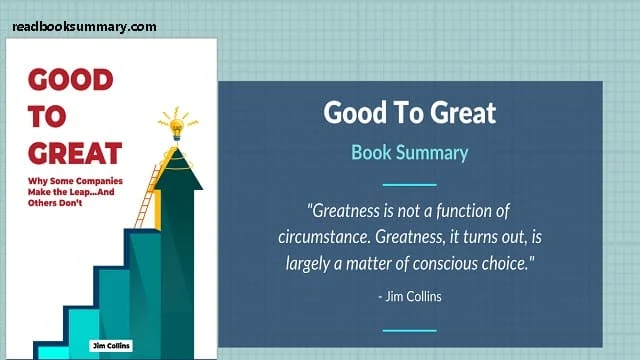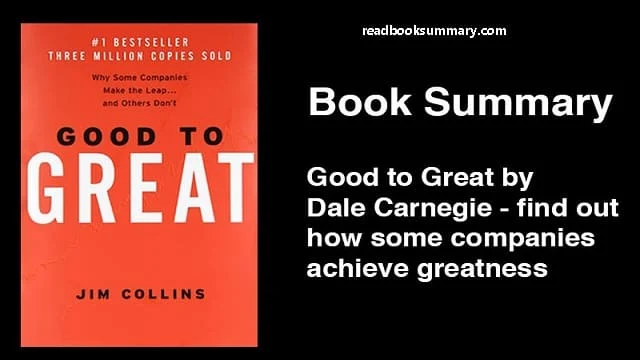Good to Great Summary. Why Some Companies Make the Leap and Others Don't is a management book by Jim Collins that describes how companies transition from being good companies to great companies, and how most companies fail to make the transition.
The book was a bestseller, selling four million copies and going far beyond the traditional audience of business books. The book was published on October 16, 2001.
 |
| Good To Great Book Summary |
Good To Great Summary
The book “from good to great " provides a model for transforming good, ordinary, or average institutions and companies to a great level, and the book includes a model that collected all the theories through which companies can build and break the barriers that prevent them from reaching great success. Collins ' advice in his book was centered on stopping focusing on short-term gains, making long-term decisions, Collins collected his advice and experience in the book “from good to great”, which will inevitably be useful to any entrepreneur, will help him to found a prosperous company.
In his chapter 1 entitled The Good is the enemy of the great, the writer explains that it is necessary to abandon the acceptance of the average, normal or good and yearn and aspire towards everything that is great, and this is the first way to achieve great success.
In Chapter 2 (“Level 5 Leadership”), Collins defines the qualities of a leader who turns a good company into a great one, naming this type of leadership “Level 5 Leadership.” Rather than relying on charisma or a big personality, a Level 5 leader “builds enduring greatness through a paradoxical blend of personal humility and professional will” (20). Without a Level 5 leader at the helm, companies seldom achieve greatness.
Chapter 3 (“First Who…Then What”) emphasizes the need to recruit and retain the right people, to remove the wrong people, and to set a mission-driven course once the right people have bought into the idea. The subsequent teams, characterized by a rigorous work ethic, debate constantly in search of consensus. Together, these teams contribute to a company’s greatness thanks to “their character traits and innate capabilities” rather than an impressive list of specific skills (64).
In Chapter 4 (“Confront the Brutal Facts (Yet Never Lose Faith)”), Collins argues that every good-to-great company must undergo a rigorous process of facing its most glaring issues. In order to acknowledge these “brutal facts,” companies must first cultivate and maintain a culture of openness where stakeholders across the organization can voice their perspective in a free and authentic manner. Adversity is common across all companies, regardless of their greatness or lack thereof, but a highly effective response to adversity requires this head-on confrontation.
Chapter 5 (“The Hedgehog Concept (Simplicity Within the Three Circles)”) draws on Collins’s research to suggest that a good-to-great is like a hedgehog—simple, seemingly unimpressive, but highly consistent. The hedgehog image serves as the basis for the three intersecting circles that combine to create greatness: what you are deeply passionate about, what drives your economic engine, and what you can be the best in the world at. According to Collins, good-to-great companies generally take four years to arrive at their Hedgehog Concept.
In Chapter 6 (“A Culture of Discipline”), Collins emphasizes the importance of a company culture where self-disciplined people are free to work within a framework shaped by high expectations and clear communication. This type of culture thrives when people at the company are self-motivated, eager to improve the company and even to suggest innovation, and not fearful that a tyrant at the helm of the company will personally discipline their wrongdoings. According to Collins, companies can only achieve this type of culture by strictly adhering to the Hedgehog Concept.
Chapter 7 (“Technology Accelerators”) focuses on using technology as a means of accelerating success, rather than creating success simply by adopting a new technology. According to Collins, applying cutting-edge technological practices is not enough to transform a company from good to great. Technology is important in a company’s constant evolution and growth, but it cannot make or break a company on its own. Furthermore, good-to-great companies strategically select new technologies that align with the core tenets of their Hedgehog Concepts, rather than simply jumping onto the bandwagon of the latest fad.
In Chapter 8 (“The Flywheel and the Doom Loop”), Collins compares how momentum builds in good-to-great companies to how it builds in others. Good-to-great companies build momentum in the same way that a flywheel does, growing over time through persistence and repetition. Comparison companies, on the other hand, often fall into what Collins calls the “doom loop”—a pattern that results from trying to skip steps along the way, ignoring the benefits of gradual momentum in an effort to achieve breakthrough as quickly as possible.
Finally, in Chapter 9 (“From Good to Great to Built to Last”), Collins contextualizes Good to Great by juxtaposing it with Built to Last. He argues that Good to Great acts more as a prequel to Built to Last, even though he conducted the research for Good to Great years after publishing Built to Last. Both books center on a question that Collins deems essential to any organization: Why do we want to be great in the first place? Collins concludes by arguing that the concepts these books lay out are relevant not only in the context of companies and organizations, but also in the context of our individual daily lives.
You may also like to read: Crucial Conversations Book Summary
Good To Great Themes
Level 5 Leadership: This concept refers to leaders who are humble and self-effacing, yet fiercely ambitious for their companies. They put the needs of the organization above their own egos and are driven by a deep desire to make a difference.
The Right People on the Bus: Collins emphasizes the importance of having the right people in the right seats before even thinking about where the bus is going. He argues that it's more important to get the right people on the bus and then figure out where to take them, rather than the other way around.
First Who… Then What: This principle suggests that companies should first focus on getting the right people in place before deciding on a strategy. Once they have the right people on board, they can then figure out what to do with them.
Confront the Brutal Facts (Yet Never Lose Faith): Great companies are willing to face the harsh realities of their situation, even when it's painful. However, they also maintain a unwavering belief in their ability to overcome challenges and achieve their goals.
The Hedgehog Concept: This concept refers to a simple, clear understanding of what a company is best at, what drives its economic engine, and what passionate about. It's the intersection of these three circles that defines a company's core identity and guides its decision-making.
A Culture of Discipline: Great companies have a strong culture of discipline, which means that everyone is held accountable for their actions and results. There is a clear focus on goals and objectives, and people are expected to take ownership of their work.
Technology Accelerators: Great companies don't rely on technology alone to drive their success. Instead, they use technology as an accelerator to amplify their existing strengths and capabilities.
 |
| good to great summary |
 |
| good to great book review |
 |
| good to great jim collins summary |
 |
| good to great synopsis |
Questions and Answers about Good To Great Book
What is the main point of Good to Great? The Hedgehog Concept: To go from good to great means that the comfort of complacency must be overcome. A culture of discipline: When the workforce is disciplined, hierarchy becomes irrelevant. When there is disciplined thought, bureaucracy is decreased.
What are the three main components of Good to Great? The good-to-great framework has three components: process, phases, and flywheel. 1. The process Encompassing the stages from build-up through to greatness, the process helps achieve the ultimate breakthrough that raises your company from also-ran to great.
What are the phases of Good to Great? The model includes three stages: disciplined people, disciplined thought, and disciplined action. Within each stage are two key concepts. Wrapping around the entire model is “The Flywheel,” which brings everything together.
What are the conclusions of Good to Great? Good to Great is a must-read for anyone committed to one day leading an organization that truly represents excellence, no matter its tax status. The book is based on the premise that “good is the enemy of great.” Collins expounds: We don't have great schools principally because we have good schools.
What is a Level 5 leader in Good to Great? A Level 5 leader is one who exhibits a combination of strong personal humility and professional will. This top level leader is incredibly driven and ambitious, maintains a healthy sense of self-awareness, and is able to put the needs of others above their own.
What is the Good to Great assessment model? 'Good to Great' (2001) identified public companies that had achieved enduring success after years of mediocre performance and isolated the factors which differentiated those 'Great' companies from their just 'Good' competitors.
How many companies were studied in Good to Great? We systematically scoured a list of 1,435 established companies to find every extraordinary case that made a leap from no-better-than-average results to great results.
What is the red flag mechanism in Good to Great? In Jim Collins' must-read book “Good to Great”, Collin's coined the phrase “red flag mechanism”. The red flag is a structure that helps leaders avoid serious missteps by empowering people on their teams to raise issues, problems, challenges, etc. immediately.
What is disciplined thought in Good to Great? Culture of Discipline is a concept developed in the book Good to Great. Disciplined people who engage in disciplined thought and who take disciplined action—operating with freedom within a framework of responsibilities—this is the cornerstone of a culture that creates greatness.
Why is good the enemy of great? One of the notable takeaways from the book is the quote and now inspirational theme that “Good is the Enemy of Great.” The concept is that too many people and too many organizations “settle” and take short cuts accepting that “good” is good enough and that they don't need to do the really hard work to be great.
What is better between good and great? Good means it desirable or it's nice. Great means it's better than good, as in very good. Wonderful means extremely good, inspiring delight or wonder as well. Example: "this pie is good" implies it was just a nice pie.
